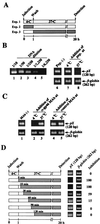Inhibition of cell-free human T-cell leukemia virus type 1 infection at a postbinding step by the synthetic peptide derived from an ectodomain of the gp21 transmembrane glycoprotein
- PMID: 10516085
- PMCID: PMC113011
- DOI: 10.1128/JVI.73.11.9683-9689.1999
Inhibition of cell-free human T-cell leukemia virus type 1 infection at a postbinding step by the synthetic peptide derived from an ectodomain of the gp21 transmembrane glycoprotein
Abstract
To investigate the roles of human T-cell leukemia virus type 1 (HTLV-1) envelope (Env) proteins gp46 and gp21 in the early steps of infection, the effects of the 23 synthetic peptides covering the entire Env proteins on transmission of cell-free HTLV-1 were examined by PCR and by the plaque assay using a pseudotype of vesicular stomatis virus (VSV) bearing the Env of HTLV-1 [VSV(HTLV-1)]. The synthetic peptide corresponding to amino acids 400 to 429 of the gp21 Env protein (gp21 peptide 400-429, Cys-Arg-Phe-Pro-Asn-Ile-Thr-Asn-Ser-His-Val-Pro-Ile-Leu-Gln-Glu-Arg-P ro-Pro-Leu-Glu-Asn-Arg-Val-Leu-Thr-Gly-Trp-Gly-Leu) strongly inhibited infection of cell-free HTLV-1. By using the mutant peptide, Asn407, Ser408, and Leu413, -419, -424, and -429 were confirmed to be important amino acids for neutralizing activity of the gp21 peptide 400-429. Addition of this peptide before or during adsorption of HTLV-1 at 4 degrees C did not affect its entry. However, HTLV-1 infection was inhibited about 60% when the gp21 peptide 400-429 was added even 30 min after adsorption of HTLV-1 to cells, indicating that the amino acid sequence 400 to 429 on the gp21 Env protein plays an important role at the postbinding step of HTLV-1 infection. In contrast, a monoclonal antibody reported to recognize the gp46 191-196 peptide inhibited the infection of HTLV-1 at the binding step.
Figures





Similar articles
-
Identification and mapping of functional domains on human T-cell lymphotropic virus type 1 envelope proteins by using synthetic peptides.J Virol. 1996 Mar;70(3):1564-9. doi: 10.1128/JVI.70.3.1564-1569.1996. J Virol. 1996. PMID: 8627675 Free PMC article.
-
Mapping of immunogenic regions of human T cell leukemia virus type I (HTLV-I) gp46 and gp21 envelope glycoproteins with env-encoded synthetic peptides and a monoclonal antibody to gp46.J Immunol. 1989 Feb 1;142(3):971-8. J Immunol. 1989. PMID: 2563272
-
Evidence that the transmembrane domain proximal region of the human T-cell leukemia virus type 1 fusion glycoprotein gp21 has distinct roles in the prefusion and fusion-activated states.J Biol Chem. 2001 Dec 28;276(52):49466-75. doi: 10.1074/jbc.M108449200. Epub 2001 Oct 10. J Biol Chem. 2001. PMID: 11595747
-
Molecular mechanisms affecting HTLV type 1-dependent fusion at the cell membrane: implications for inhibiting viral transmission.AIDS Res Hum Retroviruses. 2000 Nov 1;16(16):1731-6. doi: 10.1089/08892220050193227. AIDS Res Hum Retroviruses. 2000. PMID: 11080818 Review.
-
Molecular aspects of HTLV-1 entry: functional domains of the HTLV-1 surface subunit (SU) and their relationships to the entry receptors.Viruses. 2011 Jun;3(6):794-810. doi: 10.3390/v3060794. Epub 2011 Jun 15. Viruses. 2011. PMID: 21994754 Free PMC article. Review.
Cited by
-
Intersubunit disulfide isomerization controls membrane fusion of human T-cell leukemia virus Env.J Virol. 2008 Jul;82(14):7135-43. doi: 10.1128/JVI.00448-08. Epub 2008 May 14. J Virol. 2008. PMID: 18480461 Free PMC article.
-
An antiviral peptide targets a coiled-coil domain of the human T-cell leukemia virus envelope glycoprotein.J Virol. 2003 Mar;77(5):3281-90. doi: 10.1128/jvi.77.5.3281-3290.2003. J Virol. 2003. PMID: 12584351 Free PMC article.
-
Cell-free human T-cell leukemia virus type 1 binds to, and efficiently enters mouse cells.Jpn J Cancer Res. 2002 Jul;93(7):760-6. doi: 10.1111/j.1349-7006.2002.tb01317.x. Jpn J Cancer Res. 2002. PMID: 12149141 Free PMC article.
-
Similar regulation of cell surface human T-cell leukemia virus type 1 (HTLV-1) surface binding proteins in cells highly and poorly transduced by HTLV-1-pseudotyped virions.J Virol. 2002 Dec;76(24):12723-34. doi: 10.1128/jvi.76.24.12723-12734.2002. J Virol. 2002. PMID: 12438598 Free PMC article.
-
Pathways of cell-cell transmission of HTLV-1.Front Microbiol. 2012 Oct 24;3:378. doi: 10.3389/fmicb.2012.00378. eCollection 2012. Front Microbiol. 2012. PMID: 23109932 Free PMC article.
References
-
- Chan D C, Fass D, Berger J M, Kim P S. Core structure from the HIV envelope glycoprotein. Cell. 1997;89:263–273. - PubMed
-
- Cianciolo G J, Copeland T D, Oroszlan S, Snyderman R. Inhibition of lymphocyte proliferation by a synthetic peptide homologous to retroviral envelope proteins. Science. 1985;230:453–455. - PubMed
-
- Clapham P, Nagy K, Cheingsong-Popov R, Exley M, Weiss R A. Productive infection and cell-free transmission of human T-cell leukemia virus in a nonlymphoid cell line. Science. 1983;222:1125–1127. - PubMed
-
- Dales S, Hanafusa H. Penetration and intracellular release of the genomes of avian RNA tumor viruses. Virology. 1972;50:440–458. - PubMed
-
- Delamare L, Rosenberg A R, Pique C, Pham D, Callebaut I, Dokhelar M-C. The HTLV-1 envelope glycoproteins: structure and functions. J Acquired Immune Defic Syndr Hum Retrovirol. 1996;13:S85–S91. - PubMed
Publication types
MeSH terms
Substances
LinkOut - more resources
Full Text Sources
Research Materials

